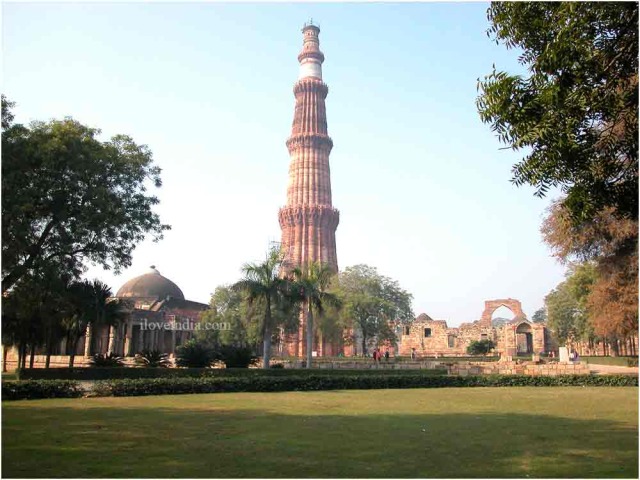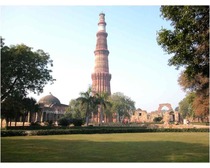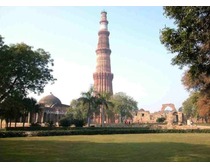Qutub Minar is the tallest brick minaret in the world. Check out some interesting & fun facts about Qutub Minar.
Facts About Qutub Minar
Qutub Minar is one of the prime attractions amongst all the historical monuments of India. Situated in the Qutub complex at Mehrauli in South Delhi, it is one of the finest examples of Indo Islamic architecture. With regard to the name of the tower, historians have conflicting views. Many historians believe that it was named after Qutb-ud-din Aibak, the first Muslim ruler of India while the others contend that it was named in honor of Khwaja Qutb-ud-din Bakhtiar Kaki, a saint from Baghdad, who was highly venerated by Iltutmish. It is believed that the construction of this heavenly monument was a result of several events that occurred in the past. However, the most important reason for the construction of this historical monument was for making calls for prayers. Moreover, the Qutub complex is also surrounded by many other architectural marvels. This fascinating structure is a well-known historical tourist destination and is declared as a UNESCO World Heritage Site. For some more interesting & fun facts about Qutub Minar, read on.

Interesting & Fun Facts about Qutub Minar
- Qutub Minar is the tallest brick minaret in the world.
- The Qutub Minar and its adjoining monuments are all listed as UNESCO World Heritage Site.
- The diameter of Qutub Minar is 14.32 m at the base and 2.75 m on the top.
- The height of Qutub Minar is 72.5 m.
- There are 379 stairs inside the tower, which lead to the top.
- The foundation of the tower was laid down by Qutubu’d - Din Aibak in 1199 AD.
- The purpose behind the construction of Minar was for the use of mu'azzin (crier) to give calls for prayer.
- The first storey was completed during the reign of Aibak.
- Many historians believe that the Qutub Minar was named after the first Turkish sultan, Qutb-ud-din Aibak. But there is a different view also. Other historians contend that it was named in honour of the Sufi Saint Qutbuddin Bakhtiar Kaki
- The next three stories were added by Shamsu'd-Din Iltutmish, the son - in - law of Qutubu’d - Din Aibak.
- The fifth and the last storey were constructed by Firuz Shah Tughlaq.
- All the stories are surrounded by protruding balconies, encircling the tower.
- The Minar contains numerous inscriptions in Arabic and Nagari characters, which narrate its history.
- During the rule of Firoz Shah Tughlaq, the minar's two top floors were damaged due to lightning but were repaired by Firoz Shah.
- In 1505, Minar was damaged by an earthquake and was repaired by Sikandar Lodi.
- The Minar was also repaired and restored by Major. R. Smith in 1829.
- According to the Archeological Survey of India, the site at which Qutub Minar is located was once occupied by 27 Hindu and Jain temples.
- Qutub Minar is made up of red and buff sandstone, containing intricate carvings and verses from the Holy Quran.
- This masterpiece of Mughal architecture is not exactly erect and is slightly tilted towards one side. This is due to the many additions and renovations that were made on the tower over the years.
- The structure of Qutub Minar is built in such a way that, the tower is widest at the bottom and narrows all the way to the top.
- The construction of the monument was made from the sculptured stones of several Hindu temples. This is evident from the Devanagari engravings on the many stone surfaces of the monument.
- At first there was a cupola established at the top of the tower, which toppled down during an earthquake. This cupola was later replaced by another cupola built in the Mughal style, by Major Smith in the 19th century, but it was taken down in 1848, as it did not suit the monument.


See also
More from iloveindia.com
- Home Remedies | Ayurveda | Vastu | Yoga | Feng Shui | Tattoos | Fitness | Garden | Nutrition | Parenting | Bikes | Cars | Baby Care | Indian Weddings | Festivals | Party ideas | Horoscope 2015 | Pets | Finance | Figures of Speech | Hotels in India : Delhi | Hyderabad | Chennai | Mumbai | Kolkata | Bangalore | Ahmedabad | Jaipur
- Contact Us Careers Disclaimer Privacy Policy Advertise With Us Lifestyle Sitemap Copyright iloveindia.com. All Rights Reserved.







